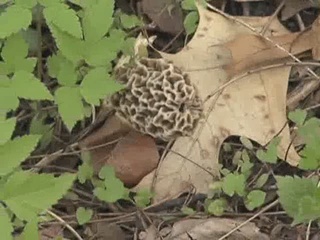
BLOOMINGTON, Ind. (AP) - Spring isn't the only mushroom season in Indiana, and morels aren't the only wild, edible fungus in the state. Fall brings other edible mushroom species, and it's already looking to be a good year, even though the autumnal equinox is still one day away.
Ed Barnett found a truly supergiant giant puffball in Lawrence County a few weeks ago.
"It's the biggest one I've ever found," the mushroom hunter said when he brought it to The Herald-Times to be photographed.
Mushroom expert Marti Crouch, who inspects wild mushrooms for the Bloomington Community Farmers' Market to make sure they are an edible species and in good condition, also said it was the largest giant puffball she had ever seen.
Crouch said she suspects the warm winter, followed by an early, wet spring, created optimal conditions for mycelia, the underground, perennial "trunk" of mushroom fungi, of which the above-ground structures are "fruit."
Mycelia become dormant in the winter and in drought conditions, but when the nutrients and soil moisture are just right, they form structures that expand out of the ground.
"The mycelia probably had a long period to grow after winter dormancy," she said. "Then they got hit by the drought, but were probably quite well developed at that point. Then came the late summer rains, so now we're having a great mushroom season."
But some mushrooms are showing up more than a month earlier than usual, including hen of the woods, whose scientific name is maitake.
Crouch has a theory about that, too: Hen of the woods grows at the base of oak trees, and the summer drought caused the trees to head early into winter dormancy, so the maitakes responded in kind. Chicken of the woods is another fall variety of mushroom.
"Normally, they don't come up until mid-October, and are only out for a few weeks," she said. This year, someone showed her a hen of the woods the first week in September. Some she saw in mid-September were already over the hill.
"People who go out hunting for hen of the woods in October probably won't find any," she said.
The varieties of mushrooms that have sprung up in grassy areas aren't early, Crouch said. They come up in response to good rains, she said.
Barnett thinks giant puffballs taste like steak, but not as rich and flavorful. He cuts them into thin strips and dries them in a food dehydrator, then stores them in airtight gallon jars. He has eight gallons of dried giant puffball strips left over from last summer, so he gave away his supergiant.
But Crouch didn't want it. She's not fond of the flavor, and she had a clump of hen of the woods mushrooms in her refrigerator, destined for the stew pot.
She couldn't say that species is her favorite of the local edible wild mushrooms.
"Talking about your favorite mushroom is like picking your favorite child or pet," she said. "They all have their own particular characteristics."
But it is dangerous to eat any wild mushroom without being absolutely certain what species it is. Some edible mushrooms have toxic lookalikes, and some edible species are toxic at certain phases of their life cycle.
There is no easy way to distinguish an edible mushroom from a toxic one, Crouch said, and there are local wild mushroom species that are lethal, if ingested, including the death angel.
"Those are the most worrisome," Crouch said. "By the time you're sick, it's usually too late to do anything about it."
She recommends learning the toxic mushrooms first, and noted that not all toxic mushrooms are deadly.
Delicious, orange chanterelles have a poisonous lookalike, called jack-o-lanterns, the most common local source of mushroom poisoning.
"I've known several people who have eaten that by mistake. They haven't died, but said they wished they were dead while they were sick," Crouch said.
Giant puffballs are edible, but only when they're pure white and smooth inside. If you find one and slice into it and find any sort of structure, it's not a puffball. Some poisonous mushrooms look like young giant puffballs.
"All mushrooms have similar species that are toxic," Crouch said.
























